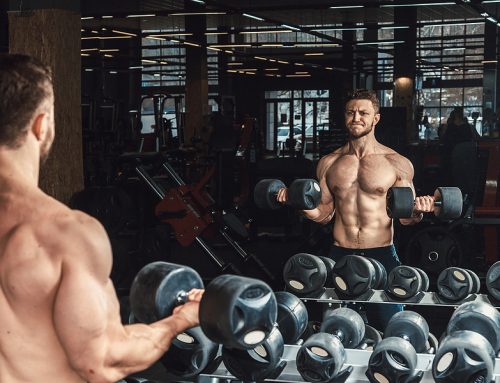How much protein you should eat per day day to build muscle? This question has been debated for years. It still is, though good science points to 1.6 to 2.2 g per kilogram of bodyweight per day as a solid guideline. (Overweight folks might want to make that grams per pound of goal bodyweight). But one question that probably causes even more confusion is this one: “How much protein you should eat at each meal?” Differently stated, “How much protein can your body absorb or digest in one sitting?” A closely related question is, “How many times per day should you eat protein?”

For years, there was never any official guideline for how much protein per meal. But then in 2018, a study on this topic was published in the Journal of the International Society of Sports Nutrition (Schoenfeld & Aragon).
This was not a single experiment about protein intake per sitting. It was a meta-analysis, which is like a study of studies (40 different protein studies were cited in this case).
The first thing the researchers did was to clear up a misconception. A lot of people ask, “What is the most protein my body can absorb or digest in one meal?” That might not be the right question. Here’s a better one: “What is the most protein I can consume in one meal that my body will use for building muscle?”
The terms “digest” and “absorb” mean that nutrients (amino acids) are passing from your gut, through the intestinal wall, and into circulation throughout your body’s systems. Based on this definition, the amount of protein you can digest and absorb is almost unlimited.
You can eat huge meals, with huge amounts of protein. (I ate a 36-ounce ribeye at the Big Texan in Amarillo once. Gotta go back one day and see if I can tackle the famous 72-ouncer under the time limit and get it free). Gigantic meals simply take longer to empty the stomach and digest. Eventually, all the protein will get absorbed. But it’s true that not all the protein you eat will be used for building muscle. That’s because you only need a certain amount of protein to turn on muscle protein synthesis. Also, your muscles can only use so much protein in one sitting.
Once you digest and absorb it, the rest of the protein can be used by other body tissues (not just skeletal muscle). Some of it could also be converted to glucose and burned for energy. This distinction was not made in some of the older protein research because many studies looked at “whole body protein utilization,” not how much protein is used specifically in muscle tissue. That’s what us muscle-heads want to know.
How much of the protein you eat per meal can be used to build muscle?
I remember back in the 1990s and into the early 2000s when most people believed that your muscles could only use 30 grams of protein per meal. The rest was somehow “wasted.” No one seems to know where this 30-gram myth came from. There was no research back then that supported this idea. But I have a hunch…
Almost all the bodybuilders in that era were eating 5 to 6 times a day. A high meal frequency was bodybuilding tradition back then, and it seemed to be working. At the same time, the golden rule for total daily protein intake was 1 gram per pound of bodyweight per day.
Suppose a bodybuilder weighs 185 pounds. That means the goal is 185 grams of protein per day. Divide that by 6 meals per day and you get 30.8 grams per meal. Split it up into 5 meals and it’s 37 grams. So there you have it. That’s a possible origin for the 30-something grams per meal idea.
It would also seem common sense that since bigger people in hard training need more total protein for the day, they would also need more protein per meal to support their bigger body mass. It doesn’t make sense that a 250 pound competitive lifter would have the same per meal protein ceiling as a 125 pound woman, does it? Yet somehow a belief was circulated that there was a fixed limit or cap on the protein amount regardless of size, gender or training status.
Many athletes believed in this 30 gram limit, so they didn’t eat more than that at one time. (They spread their daily protein into many small meals). But others insisted that the 30 grams per meal rule was a myth.
Research on the 30 grams of protein per meal ‘limit”
This became such a contested topic that scientists finally started doing experiments to answer to this “how much protein per meal” question. In 2013, one research group found that muscle protein synthesis was maximized at a protein dose of 20 to 25 grams per meal. This reinforced the logic of spreading protein throughout the day in multiple small feedings.
But there were some problems with this study. For example, they didn’t take into account all the factors that influence protein needs. That includes type of exercise, intensity, amount of lean body mass, age, and type of protein. Subjects were fed pure whey, a fast-acting protein which may not have sustained rates of muscle protein synthesis like whole food protein sources or slower-digesting supplemental proteins. They also failed to take in adequate amounts of total protein for the whole day. (Only 80 grams across four meals).
As a result, the findings were considered inconclusive. It’s interesting that protein synthesis can be turned on with as little as 20 to 25 grams per meal. But many experts still didn’t believe the upper limit on usable protein per meal was that low. Confirming that suspicion, a follow up study found that a resistance-trained group consuming 40 grams of protein per meal had a muscle protein synthesis rate 20% higher than a group that consumed only 20 grams. The researchers speculated that the intense weight training these subjects were doing increased the muscle’s demand for amino acids.
Obviously, training increases protein needs. The humorous meme, “Do you even lift?” is appropriate when studies on protein and muscle growth are quoted but the subjects aren’t even training.
It’s also clear that short-term studies can’t answer the “how much protein per meal” question either. Measuring protein synthesis after a meal is just one point in time. This can help us hypothesize about what would happen over weeks and months, but long-term studies are necessary to see if a protein recommendation turns into actual muscle gain.
Eventually, some studies lasting 8 weeks or more were done. The findings were interesting. In one experiment, the subjects were fed large portions (“boluses”) of protein in fewer meals. Surprisingly, they maintained their lean body mass as well as when the protein was spread out, as long as the total protein at the end of the day was in the optimal range.
This suggested that the protein limit per meal was much higher than only 20 to 30 grams. It also caused speculation about whether it’s necessary to eat protein 5 or 6 times a day like bodybuilders typically do.
Unfortunately again, some of these studies were done on untrained people. Other studies didn’t find any significant difference in muscle gained. The only thing this told us for sure is that during fat loss programs, if total protein is adequate for the whole day, it doesn’t seem to matter whether protein was spread into smaller, more frequent doses, or eaten in fewer, larger boluses.
What happens if you eat huge servings of protein in fewer meals?
Research in the area of intermittent fasting (IF) seemed to confirm the idea that it’s okay to cram more protein into fewer meals. Followers of IF usually eat fewer meals because this type of diet mandates a time restricted eating period. For example, an IF practitioner might go without eating for 16 hours and then fit all their meals into an 8 hour “eating window” (10 am to 6 pm for example). Often this is the usual 3 meals a day squeezed into that window. In some cases, only 2 meals a day are eaten.
Some studies have shown that people on this type of diet lose fat, and yet they don’t lose lean body mass, even with as few as 2 meals a day. The catch is, they still have to be lifting and hit their total protein goal for the day. A downside of a low meal frequency is that most people fall short on protein for the day. For the 185 pound bodybuilder aiming for a 185 gram per day total protein goal – that would mean 62 grams per meal in 3 meals. If your protein goal is 185 grams a day and you eat only twice a day, that means you’d have to eat a whopping 93 grams of protein per meal!
This research was interesting, but it didn’t prove that fewer meals with more protein per meal was effective for muscle gaining programs. It only showed that large doses of protein in fewer feedings work for fat loss and don’t cause loss of muscle you already have. It raised practical questions as well, such as, wouldn’t it be easier to hit your daily protein goal if it were spread into 4 or 5 meals?
It also didn’t answer the big question about how much protein per meal can be used for muscle growth. What if that number was only 50 grams per meal? If that were the case, then wouldn’t that mean 3 protein feedings a day should be the bare minimum, and 4 to 5 even better?
For a long time, this continued to be a complicated issue to settle scientifically. It’s hard to do the type of research necessary to determine ideal protein frequency for muscle growth. It became clear that a study won’t answer the how much protein per meal question accurately unless:
1. The subjects are lifting.
2. Total protein (and calories) for the whole day are sufficient to support muscle growth.
3. Change in lean body mass is accurately measured over time.
4. Muscle gain is measured, not just fat loss or muscle maintenance while dieting.
At least one study met these criteria and compared high protein and lower protein diets in 3 versus 6 meals in resistance trained subjects. The only group that gained a significant amount of lean mass was the high protein 6 feeding group. That doesn’t mean you have to eat 6 times a day to gain muscle, but this experiment did suggest that spreading out protein across the day in multiple feedings is optimal.
Research reveals the “magic number” for grams of protein per meal
By the year 2015, scientists finally had enough data to answer the protein per meal question and put a number on it. They said the minimum amount of protein to optimally stimulate muscle protein synthesis is 0.4g/kg per meal. If you crunch the numbers, for the 185 pound bodybuilder (84.1kg), that’s 33.6 grams of protein per meal.
Researchers also estimated that the protein per meal upper ceiling was probably around .55g/kg and might be as high as .6g/kg. That would be an upper limit of 50.5 grams of protein per meal for the 185 pound man. That range (approx 30 to 50 grams of protein per meal) is surprisingly similar to how much protein most bodybuilders eat per meal, even back in the 1990s, before any of this research was done.
In the 2018 meta analysis, the authors took all this data into consideration and came up with the first official scientific guideline for the maximum amount of protein per meal that can be used for building muscle:
“Based on the current evidence, we conclude that to maximize anabolism one should consume protein at a target intake of 0.4 g/kg/meal across a minimum of four meals in order to reach a minimum of 1.6 g/kg/day. Using the upper daily intake of 2.2 g/kg/day reported in the literature spread out over the same four meals would necessitate a maximum of 0.55 g/kg/meal.”
If you eat more protein per meal than this, there’s no harm, but you shouldn’t expect it to build more muscle. The protein may be used elsewhere in the body, or simply get oxidized for energy. Protein is the least likely macro to get stored as fat when you over-eat it, but with large calorie surpluses, excess protein could also get stored as fat.
If your intention in eating a gigantic meal with 60 to 90 grams of protein is that you prefer the convenience of eating less often or you enjoy feeling fuller and so on, that’s one thing. But if your intention in eating huge protein meals is thinking it will build more muscle, it won’t. It’s true that your muscles can only use so much protein at once.
The ideal protein intake frequency
Having a new guideline for protein per meal helps us answer another burning question: “What is the best way to spread your protein through the day?”
Some of the same scientists who came up with the .4 to .55g/kg/meal guideline say that the optimal daily protein intake for resistance trained people to gain muscle in normal conditions ranges anywhere from 1.6g/kg/day to 2.2g/kg/day. If you do the math, that upper number is 1 gram per pound of body weight per day – similar to what bodybuilders have done for years. Returning to our 185 pound bodybuilder, if he wanted to hit the upper end of this range, he would be aiming for 185 grams per day.
If the maximum amount of protein you can use per meal is 33 to 46 grams per day (based on the formula .4 to .55g/kg/meal) that means 185 total daily protein grams divided by 33 protein grams per meal would call for 5.5 meals. 185 grams spread into 46 grams per meal would call for 4 meals. It appears this provides support for spreading protein over at least 4 meals a day and possibly 5 depending on the person, if the goal is to optimize muscle growth.
You might be reading this and saying, “It looks like the bodybuilders were right all along if they recommended 4 to 6 meals day.” For muscle building purposes that’s probably correct. But an ideal number of meals may also depend on your goal and on your total protein target for the day.
Remember, the ideal amount of total protein per day falls in a range (1.6 to 2.2g/kg/bw/day), it’s not a single number. Some people want to hit that upper number, while others are satisfied with the low or middle end of that range. In addition, large-bodied and active people will need more protein than small and sedentary people. Those with lower daily protein targets can hit their protein goals with fewer meals needed.
While the research we discussed here suggests 4 meals as a minimum when muscle gain is the goal, anywhere in the 3 to 6 meals per day zone could work, depending on your body, your goals, and your preferences. What’s most important is you eat a high quality protein with every meal and you hit your optimal protein intake for the whole day.
Based on the science, it doesn’t look like a good idea to eat only 1 or 2 meals per day and try to cram all your protein into those meals. Most people who eat less than 3 times per day end up falling short on protein. Even if you manage to hit your optimum daily protein amount in 1 or 2 feedings, the science shows that it’s more effective to spread protein across the day.
If your goal is fat loss and you can hit your optimal daily protein intake in 3 meals, you’ll probably see great results. If your goal is muscle growth, it looks like 4 to 5 protein feedings a day is ideal.
Train hard and expect success!
Tom Venuto, Author of Burn the Fat, Feed the Muscle Guide To Flexible Meal Planning
Founder and CEO, Burn the Fat Inner Circle,
The support community for all-natural no-BS body transformation
Tom Venuto is a natural bodybuilding and fat loss expert. He is also a recipe creator specializing in fat-burning, muscle-building cooking. Tom is a former competitive bodybuilder and today works as a full-time fitness coach, writer, blogger, and author. In his spare time, he is an avid outdoor enthusiast and backpacker. His book, Burn The Fat, Feed The Muscle is an international bestseller, first as an ebook and now as a hardcover and audiobook. The Body Fat Solution, Tom’s book about emotional eating and long-term weight maintenance, was an Oprah Magazine and Men’s Fitness Magazine pick. Tom is also the founder of Burn The Fat Inner Circle – a fitness support community with over 52,000 members worldwide since 2006. Click here for membership details
Scientific references:
Schoenfeld B, Aragon A, How much protein can the body use in a single meal for muscle-building? Implications for daily protein distribution. Journal of the International Society of Sports Nutrition (2018) 15:10







Is this math correct? (I will simplify here, because this seems very complex with all the variables. I’m getting all the numbers from the internet and my consequent calculations, that I present here. Corrections are welcome.)
From the article, it seems like a 385 lb man needs to eat 385 grams of protein. 100 grams of pork chops contains about 25.7 grams protein. From that (385/25.7) this person have to eat a daily 14.98 (lets say 15) 100 gram pork chops or 1500 grams or 3.3 lbs. That is 1.1 lbs of pork chops a meal if 3 meals or 0.66 lbs if 5 meals… if 4 chops are approximately 1.5″ thick and weigh 1 pound, than 3.3 lbs of pork chops are about a 20″ long pork roast. Seems to be a lot of pork to chow down on. It is also approximately 3452 calories. (Every doctor I ever talked to said I shouldn’t eat more than 2200 calories a day if I want to lose weight, but I know already that I shouldn’t listen to doctors.)
Google reports a 100 grams of stake contain 26 to 32 grams of protein, so the math would run very similar to or somewhat less, but still (for me) a staggering, amount of meat to eat a day.
On the other hand, if one scoop of protein powder contains 28 grams, with 24 grams of protein in it, that is about 16 scoops a day or 5.33 scoops per meal if 3 meals a day, or 3.2 scoops per meal for 5 meals. Again, this seems to be a lot of very thick shakes.
I have never put more than 1 scoop of protein into any of my shakes and have not remember ever drinking more than a shake a day. Looks like I’m doing it all wrong?
Is this math solid? And if it is, how can someone eat this much protein a day? Or is there an alternative form of protein?
Hi John. how much total protein per day is ideal (for weight training individuals) has been cited in scientific literature as 1.6 to 2.2g per kg bw per day. Thats. 0.73 to 1.0 g per pound of bodyweight. However, in the first paragraph I also mentioned that overweight people will overestimate protein need using that formula and should use pounds of goal body weight. So if an obese man weights 385 pounds he certainly does not need 385 grams of protein a day. thats total overkill. Suppose his goal weight is 220. Then he would aim for 220 g. But even that is a LOT. So I would again call attention to the fact that the ideal daily protein amount is a range not a single number (1 g per lb of bw has been a classic rule for decades but it’s a rule for bodybuilders who are already lean). As little as .7 to .8g per lb probably covers the bases. Protein prescription is far more nuanced and individual than telling everyone “1 gram per pound of bodyweight”. and as the blog post discusses, once you’ve got your total daily protein goal, it is ideal to spread out the protein into multiple feedings